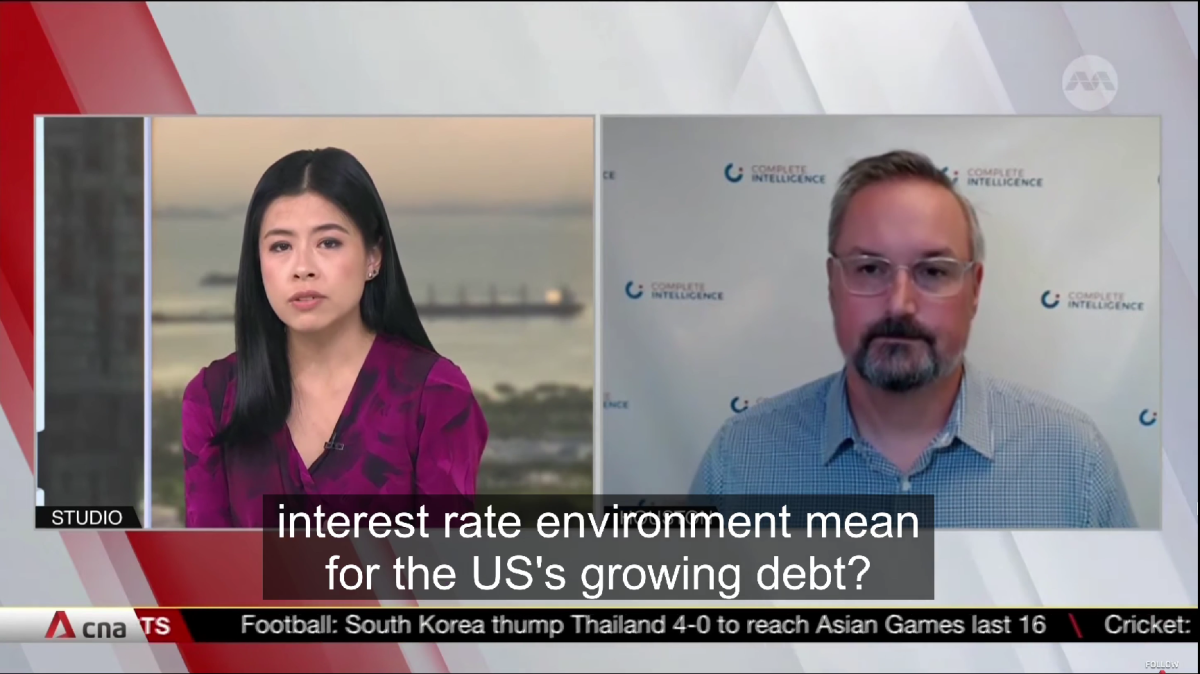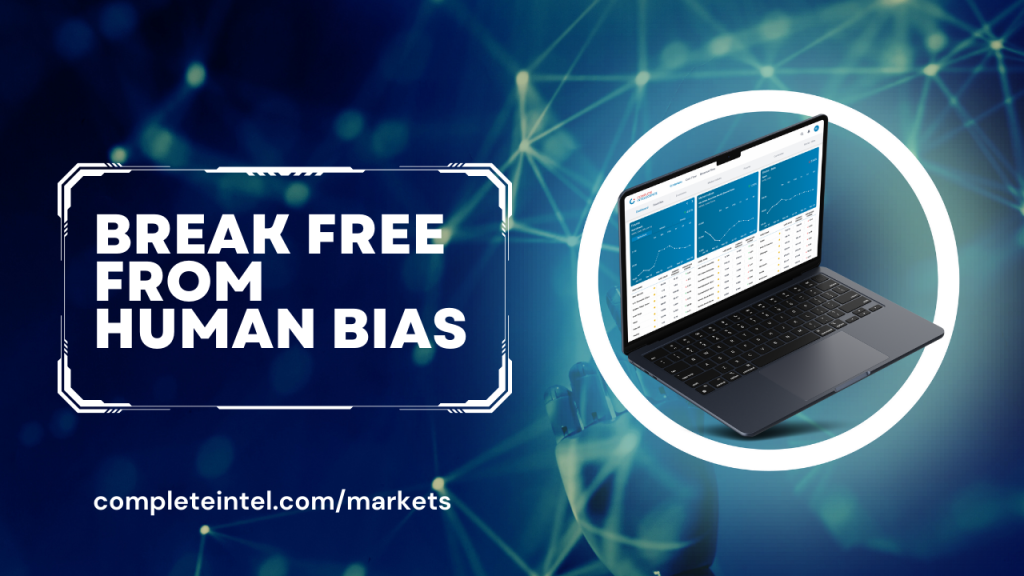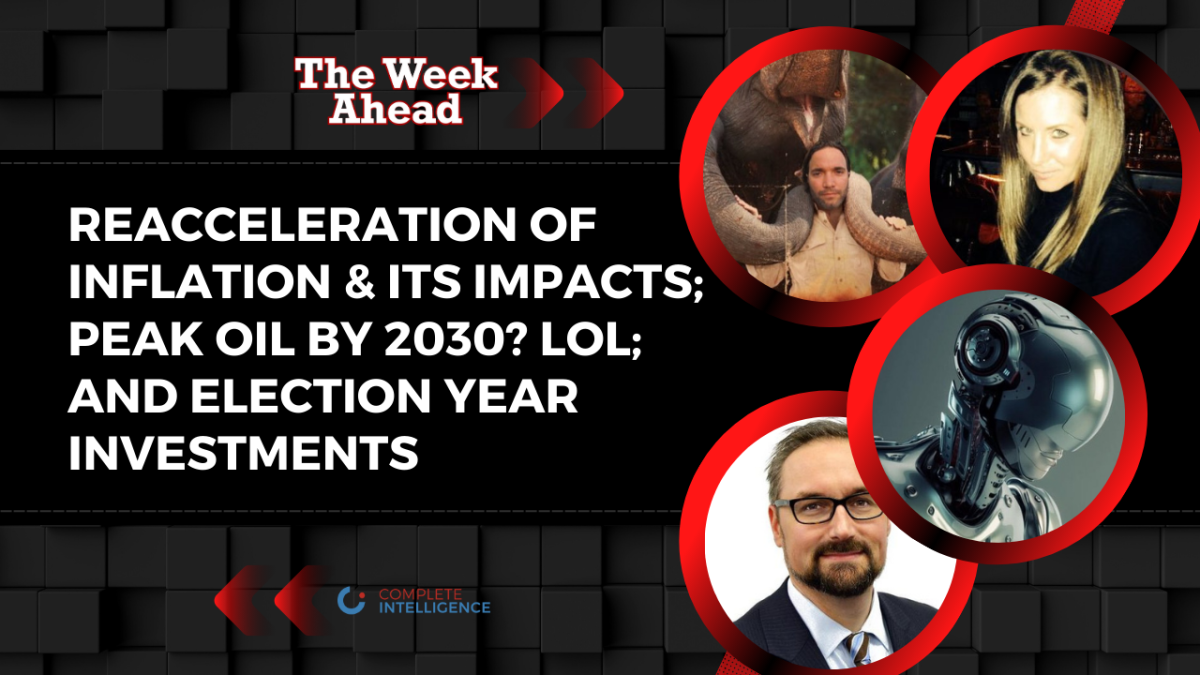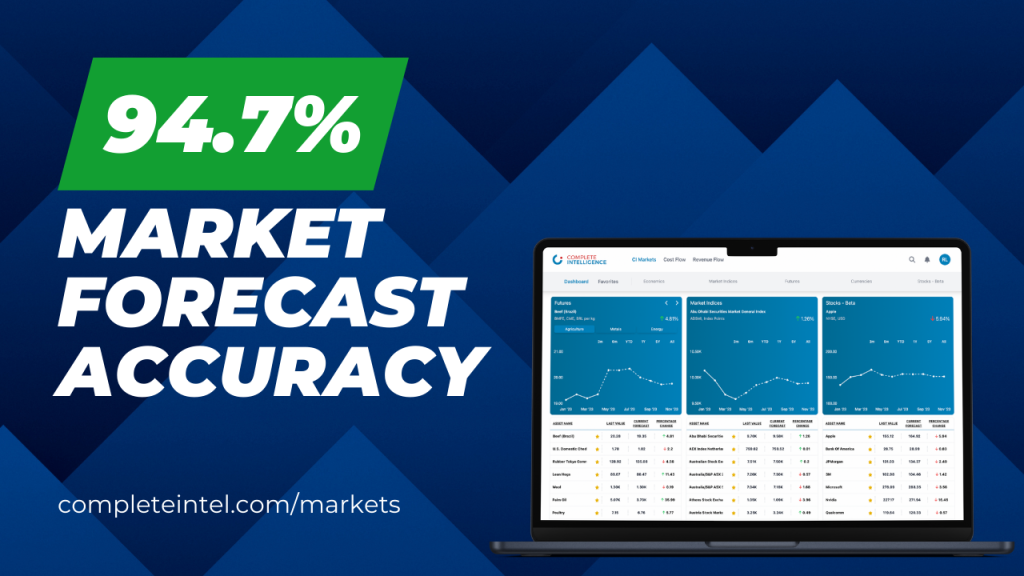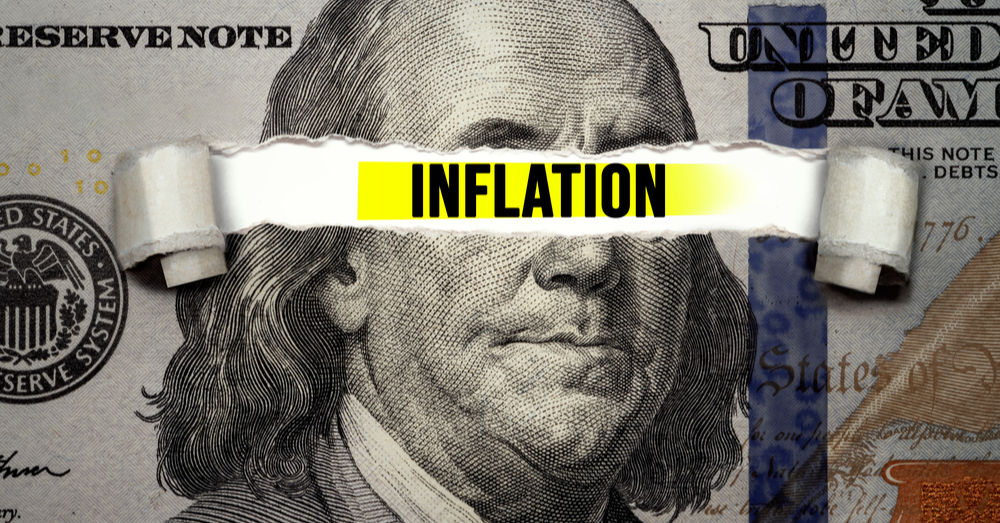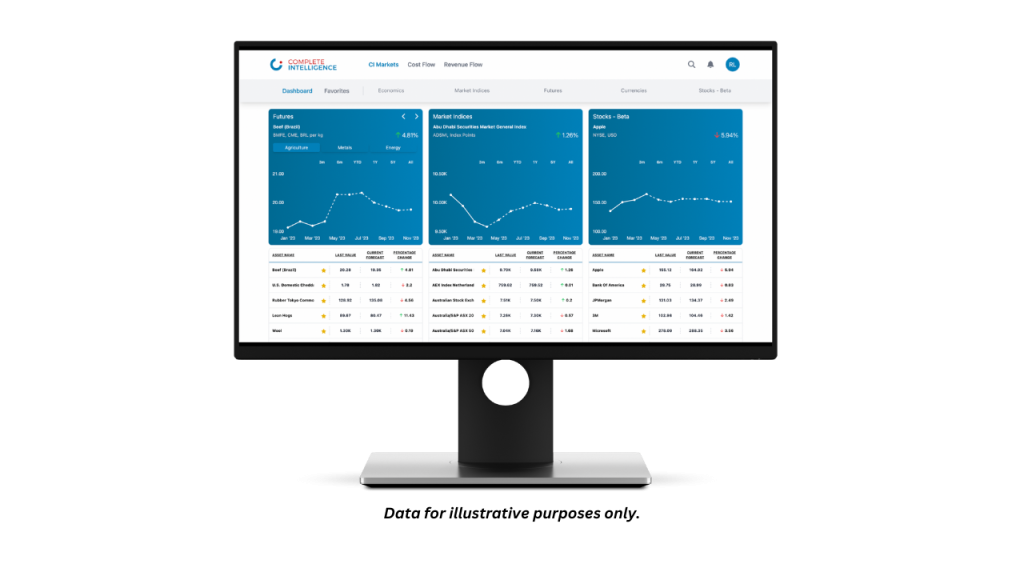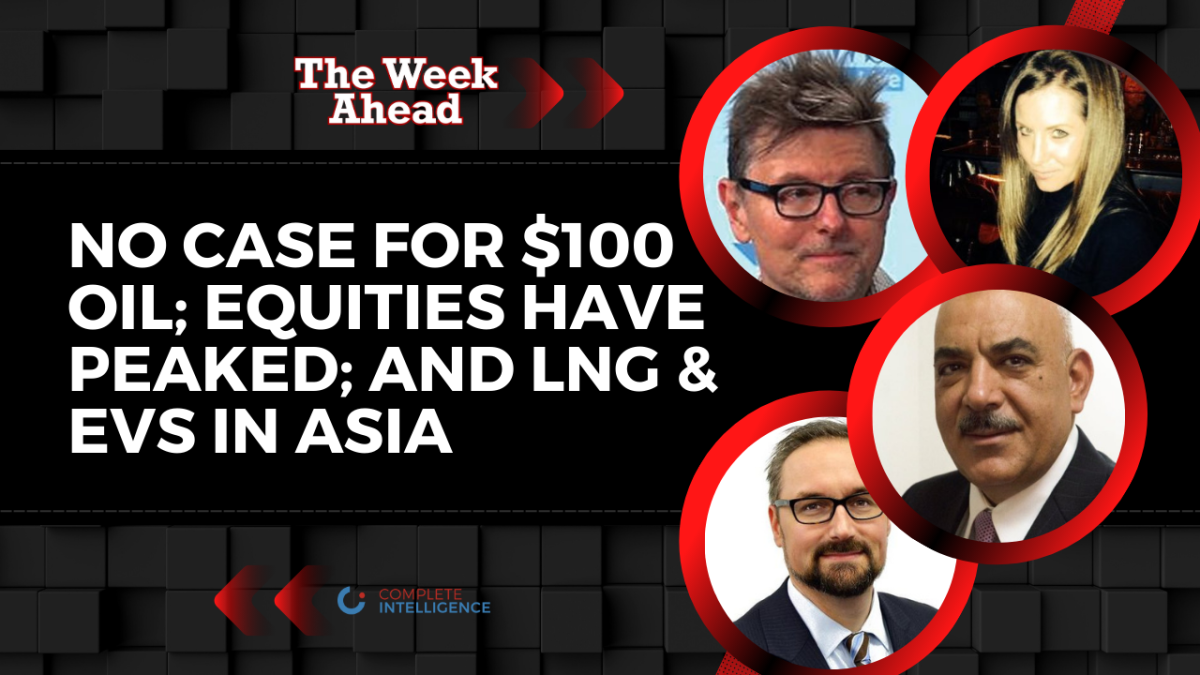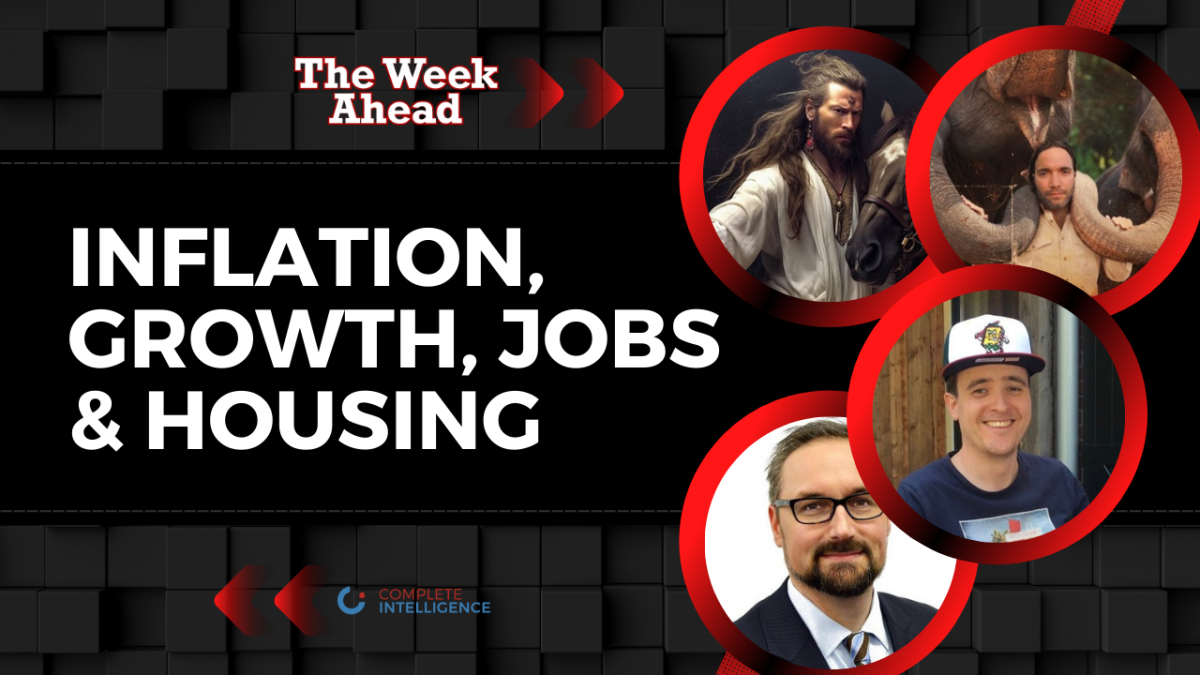Register for a CI Markets account for FREE! No credit card required:
Hosted by Tony Nash, this week’s panel of experts includes Dale Pinkert, Tony Greer, and Albert Marko. Together, they discussed critical topics that matter to you:
- How low will TLT, SPX, and Gold go?
One of the burning questions today is the trajectory of TLT, SPX (S&P 500), and Gold. With the S&P 500 approaching the 4200 mark and bond yields on the rise, the panel discussed the numbers. TLT’s descent to levels not seen since 2006/2007 is interesting. Do these trends present unique opportunities or do lingering uncertainty clouds the horizon?
- Identifying the Tradeable Bottom
Tony Greer explores the VIX and SPY, examining whether we’ve reached a point where markets are poised for a rebound. Gain insights into the indicators he watches closely to signal a potential tradeable bottom and what lies ahead for the S&P 500.
- Government Shutdown Implications
With the specter of a government shutdown looming, Albert Marko takes the stage to analyze the potential consequences. Governments’ actions can have a profound impact on financial markets, and understanding these dynamics is crucial for investors. Discover what he foresees in the event of a government shutdown and how it could affect your investments.
Transcript
Tony Nash
Hi, everyone. Welcome to the week ahead on Tony Nash. Today, we’re joined by Dale Pinkert, Tony Greer, and Albert Marko. Guys, thanks for taking the time on this Friday. It really means a lot. Today, we have a number of key themes. We’re going to talk to Dale about TLT. We’re going to talk to Tony Greer about tradable bottoms, and we’re going to talk to Albert Marko about the government shutdown.
Before we get started, I want to let you know about a new free tier we have within CI Markets, our global market forecasting platform. We want to share the power of CI markets with everyone. So we’ve made a few things free. First, economics. We share all of our global economics forecast for the top 50 economies. We also share our major currency forecasts, as well as Nikkei 100 stocks. So you can get a look at what do our stock forecast look like. There is no credit card required. You can just sign up on our website and get started right away. Check it out. CI Market’s free. Look at the link below and get started ASAP. Thank you.

Dale, really glad to have you here today.
Thank you so much for taking the time. It’s your first time, and we’re really glad that you’ve made the time for us.
Dale Pinkert
Great to be here, Tony.
Tony Nash
Thank you very much. We’ve seen the XPX approach 4,200 and bond yield spike and continue to rise, and TLT continues to fall, of course, as yield spike. We’re seeing TLT hit levels we haven’t seen since 2006, 2007. It seems to be one of those times where people are saying, We’re at levels we haven’t seen since X, in a lot of ways. How do you see this going? Is this an opportunity? Is there’s too much uncertainty? Where do you see that debt and equity environment?
Dale Pinkert
Well, on other broadcasts and people have been following me know that I’ve been looking for the October Low in TLT to be taken out. On the weekly chart, it was a confirmed low market to rarely bottom when momentum is confirming price. And all we did was move sideways. Took care of that low a few days ago. We’re not confirming this time. I won’t be pressing the short side of bonds anymore. I think that yields are in a peaking process, and it’s most likely to be a growth scare that generates lower yields, a lower again. And even though the path of living response would be to buy equities, I think equities are part of the weakness that would go along with that.
Tony Nash
So when you say growth scare, what do you mean by that?
Dale Pinkert
Just the employment report that we would have gotten next week, I was looking for that to cement it. As Albert said, the feds can be using different stats to judge it, and we won’t know that number. I expect this to last at least a couple of weeks into the eclipse. Don’t call me a kook, but I’ve seen a lot of astronomical things be turning points in the markets over the years. And eclipses are something that people that do planetary stuff, it can be a time of, like the ancients believed of famine, war, not good omens. And plus we had the—I’ll steal the deal—we had that comment with the Green Tail that hasn’t been around since 1623. I don’t know what we were trading in 1623, but that’s-
Tony Nash
Tulips?
Albert Marko
Tulips.
Dale Pinkert
Yeah. So there are a lot of things, messages in the heavens besides our charts. Price action is king, but I pay attention to things.
Tony Nash
Like that. Dale, I don’t think you’re a cook for mentioning astronomy because have you ever seen a technical trainer? I’m kidding, but so – I.
Tony Greer
Was going to say, Dale, you have an astronomy ticker on Bloomberg that I could start watching.
Tony Nash
Exactly. So, no, seriously –
Dale Pinkert
Hey, you could join me in my pyramid and put on a tinfoil hat anytime, Tony.
Tony Nash
No, look, I love it. People trade based on different things, right? And none of it’s crazy because we can infer causality or whatever from anything we want. So I want to go down that kook trail for a minute because I think that’s really interesting. From the astronomy perspective, tell us about the eclipse and what that means. I know this to people who are watching this may seem a little bit weird, but I’m actually really interested in this.
Dale Pinkert
Okay, well, this is the first time ever, which is a long time, that people are going to be able to see an annular eclipse with the Ring of fire. It’s going to be a long time before another one shows up. So yeah, there’s another sign. I learned about things like this from others. There’s nothing new under the sun. I have to give Chris Carolyn a tip of the hat for tuning me into lunar things and tides and eclipses. And I always had an interest in a vibe from them anyway, and I paid attention to them. I’ve seen a lot of turning points on eclipses. I’ve seen them in the dollar. I’ve seen them in metals. And I just think that the technical set-ups are being confirmed by what’s happening, the other signals that we’re getting that most people are oblivious to.
Tony Nash
Okay, that’s interesting. I have a lot of Indian friends for those of you who know me or people who watch my feed. My son is Indian. I spend a lot of time in Indian culture, that thing. I’ve had several Indian traders tell me that they look at Star Charts as a part of their trading strategies. Again, these things may sound kookie to people, but people look at this stuff. And so in terms of a change, like a turning-
Dale Pinkert
Art Crawford, he was another guy that I used to be interviewed with on CNBC and FNN before it became CNBC. He’s another planetary guy. I’m sorry I interrupted you.
Tony Nash
No, no, that’s great. What is the turning point that you expect? You’re expecting yields to fall a bit? What is that turning point you’re expecting?
Dale Pinkert
Yeah, I’m expecting everyone that was wrong-footed about six months ago looking for the pivot are on the other side of the fence now. I know we can’t show our charts now, but the tenure did what I call is a throw-over, where it trades above a return line and then re-entered it yesterday, and I think that yields are peaking because of market events, not because of the Fed, but because there’s going to be some fear. I know for a long time, the flight to quality trade hasn’t worked, so most people are discouraged from even attempting it. But I think that even if it doesn’t work, the bonds will not be as vulnerable as equities may be. We’re already seeing it in certain markets. Look at silver. From being up to 70 cents to being down 40, you know what that tells me? We have a problem with market structure and liquidity for silver to put in the day it put in today. Because I know Tony’s been trading a long time and Albert, and you, when’s the last time you saw a range like that in silver? Without any news.
Tony Nash
Tony Greer?
Tony Greer
There’s nothing you could tell me that happened in Silver that would shock me. You know what I mean? It is and has always been a rich man’s casino. People make big bets in Silver. They underestimate what one person’s liquidity does to the market, meaning when one participant decides that they’re getting in or getting out, that has a holacious effect on markets nowadays that are largely electronically driven and front-run and all that. So nothing would shock me in terms of what I would see in silver. I mean, that is an anomaly. It doesn’t happen very often, but yeah, silver is a beast of its own.
Tony Nash
So since we’re talking about silver, can you also talk to me about gold as well? Because a couple of months ago, everyone was on the gold bandwagon. Gold was resurgent. Everyone was moving toward gold. And now it’s just can’t get a bit. It’s way down. A lot of problems. Miners are seeing it, everything else. Can you, Tony, Dale, Albert, can you guys talk to us a little bit about what’s happening in gold?
Dale Pinkert
I’ve been looking for 1800 for months. Okay. And I’ve been bullish to dollar that’s been part of it. I think that around 1800 to 1780 and Silver 2040-ish is going to be a place where I’m going to be getting long. And you bring up the miners, Tony, that even gold bugs—and I’ve talked to Tony about this, we talked a week or so ago—that even the gold bugs that were trying to avoid losses and equities by going to the miners lost it in miners. And they’re so disgusted, people are so disgusted with the miners that they’re throwing up their hands and surrendering. I think that’s a multigenerational low coming in here, around ’24-ish in GDX. I’ve promised people I work with, I won’t talk about the short side of gold and silver once we get down there for a couple of years.
Tony Nash
Really? Okay. Albert, what are you thinking about gold?
Albert Marko
There’s not much more I can add to what Dale said. I agree with Dale. I think 1800, I could even see it going to 1700. The gold would be an excellent long position. For me, I was never a fan of the whole narrative of gold is going to replace the dollar and so on and so forth. I’ve always been apprehensive of even touching gold. But Dale is right. That 17, 1800 is probably a very good long position at that point.
Tony Nash
Yeah, we even saw Chinese gold sell off earlier this year.
Albert Marko
Well, everyone needs dollars, Tony, so they’re going to sell everything under the sun.
Tony Nash
Yeah, exactly. Tony Greer, what are you thinking about gold?
Tony Greer
Gold chart looks like crap. I’m out of reasons to be bullish. I mean, it just does. There’s a triple top. That is one of the scariest triple tops I’ve seen. And they say that there’s no such thing as a triple top. We’ll show them this gold chart right now with a triple top at 2100 and a pullback to 1850 right now. But I like Dale’s position where it looks like 1800 is in the cards here. It’s one of those things where people pile into a little bit heavier during inflationary scenarios. And once they’re in, you have the story, the narrative of the central bank buyer versus the producer seller. And what it looks like is maybe some of the central bank buyers got filled and the producers keep selling. And so it’s been a while where gold has been outperforming real rates tremendously, where gold could have pulled back a long time ago. So maybe this is just gold’s pull-back-into-line moment. Quite honestly, I thought that it was going to have a chance to break through that top or we failed again. And now I don’t even know what to say to be bullish.
Tony Nash
Okay. How much-. Go ahead, Dale.
Dale Pinkert
All right. Well, March was a very important time frame. We had a low in the S&Ps at 3,800. We had the gold low at 1,800. We had dollar peaks, which a dollar is now surpassing. I’m looking for a reset in all of these markets to revisit the March lows. I think the S&P will hold above it, around 3,900 after the market makes a stand at 4,200 but fails. I’m thinking that happens into the eclipse.
Tony Nash
Okay, great. Now you mentioned the dollar, and is this gold issue more a function of dollar strength? And where do you expect the dollar? Because it was almost two years ago in, I think, SEPA ’22, where gold was at what, $1,250 or something? No, sorry, the dollar, or DXY was at $1,150 or something like that.
Dale Pinkert
Okay.
Tony Nash
Do we see more dollar strength coming in the next month or so?
Dale Pinkert
It’s a little trickier now because we’re getting to FIBs. We’ve retraced that decline from 114 to 99 and a half. We’re almost at the 50 %. 61, eight is about 109 in the ballpark. And if you want to get real bullish, well, then you drink milk shakes, if you want to be real bullish. But 78, 6, about 111, I’m thinking around 109. And I think Tony could verify this. Gold can rally with the dollar going up, but it’s very difficult to find an example where silver thrived without a bear market and the dollar. So if I’m correct and this is a failing rally in the dollar up towards 109, then I think that’s going to be the sacrificial lamb to bring things back, is the dollar and letting the dollar go. And so that’ll bring back everything, even in nominal terms, will bring back the market.
Albert Marko
It’s fascinating, Tony, because I have almost the exact same levels and set up, as Dale mentioned, but for almost entirely different reasons. Because for me, I look at what the political atmosphere is doing, and then I make assessments talking to my individuals and saying, Okay, well, 109, 110, which I’ve been calling for for quite a long time, and the dollar was most likely our top, and 3,800 is probably where we’re going to have to go back to reset to get another rally into the market, but for entirely different reasons, which is quite fascinating.
Dale Pinkert
Well, I’m going to turn off that camera you have in my office, Albert. Anyway, you know what? That gives me more conviction about what I’m saying here. I really love confluence of… I interview a lot of people, and I get it’s almost like a confirmation. From people who someone may be an elitistician, Tony does pattern recognition, and when people from different disciplines are coming to the same conclusion, I think it’s a higher probability outcome.
Albert Marko
Yeah, and the dollar from my point of view, is like you start going into the 110, 115 area, things are going to break overseas-
Tony Nash
The instruction.
Albert Marko
-systemically destroyed. And the Fed and the Treasury know this, and they’re not stupid enough to keep it up at and have Europe meltdown or have all of Asia meltdown. They’re just not going to do something like that.
Tony Nash
Okay, so dollar 109, 110, right? Then it turns around. S&P at 3,200?
Albert Marko
No, I don’t think it’ll go that far.
Tony Nash
Did you say 3,800? Sorry.
Albert Marko
3,800, I think. 38, 39 is where they want to probably come back to and then reset and relaunch.
Tony Nash
Okay. Does that sound about right, Dale?
Dale Pinkert
I’m looking for to rally back to 4,250 or so because that’s a pivot. 4.2 is a big number, and I think there are tiers under 4.2. Also, when everyone looks for one number, I’ve noticed over the years—you can tell I’ve been trading for about a thousand years. It either never gets to the number, doesn’t achieve it, or the number doesn’t matter and it melts through it. Actually, I think this is going to be more prolonged, and my longer term target is 3k S&P. It’s taking out the October low by the first quarter of next year.
Tony Nash
3k. Okay, interesting. Tony Greer, what do you think about that?
Tony Greer
I have an opposite view. I don’t get too terminally bearish in the S&P. I think it’s going up. I understand that there’s been a real eight % pullback from the highs here that could very well get steeper. I’m not calling like a bottom. Don’t quote me on that at all.
Tony Nash
Right.
Tony Greer
It seems like sell-offs are going to be managed. The economy refuses to dump into a recession, which is why the stock market is going to be able to handle higher yields. Now, I do think that yields are going to work their way higher. I just don’t think that it’s going to necessarily break all of the bull markets that exist within the S&P. And I’m talking about the AI bull market within technology, the home construction market. And I understand that we got some weak housing data and there’s some struggles with mortgages and stuff like that. But people always adjust. And I just feel like I can’t just decide that rates are going higher and jump in and have a consensus view that the stock market is backing off. I just don’t see it that way. Like you said before, like we mentioned, I look to trade bottoms, and I think that we’re getting close to one here. Whether it’s another 200 points from here, I don’t know. It’s going to depend on behavior and whether or not we get a real capitulation, which we haven’t seen even close to, but I’m hoping for. If we get that, then I’ll be putting some chips on the table for a run substantially higher in the next six months back to the S&P highs.
Tony Greer
Then we’ll see from there.
AI
Heads up for a short break. Are you using the potential of AI in your portfolio management strategies? With an impressive 94.7% forecast accuracy on average, you can confidently integrate AI into your approach with CI Markets. Visualize the potential volatility of your portfolio over the next 12 months and gain insights into specific assets that might experience fluctuations. This empowers you to make informed decisions on when to buy, sell, or hold. CI markets covers a wide range of over 1,600 assets, including stocks, commodities, forex, indices, and economic indicators. Imagine running limitless portfolio scenarios to optimize your gains. Curious about the outcome of removing or adding certain assets? Wondering how your portfolio might evolve in the next 3, 6, or 12 months? CI Markets equips you with answers to these crucial questions. Whether you seek a streamlined portfolio analysis, wish to explore diverse scenarios, or aspire to track your investments with precision, CI Markets is the ultimate tool for you. Ready to learn more? Visit us at completeintel.com/markets.
AI
Thank you and now back to the show.
Tony Nash
Hold on.
Tony Greer
Let’s stop.
Tony Nash
Before we get too far into that. Let’s give a perfect segue to our next topic of tradable bottoms. You and Tracy Shuchart, who’s a regular guest, of course, had a really interesting exchange about VIX and SPY saying we haven’t hit a tradable bottom yet. So can you talk us through what you look for in a tradable bottom?
Tony Greer
Yeah. I literally have an account in my trading account that sits in cash until the VIX trades 30, right? And that’s one of the basic ideas is just when there’s blood in the streets and total panic happening, that’s when you have to keep your head and be able to put money into the markets. And ideally, you get there on a slow burn up towards, say, call it 30 or 30 something, and then all of a sudden, you walk in on a Monday morning, there’s bad news out. The S&P is dangling at a new low. The VIX has bid a new high, and everybody’s like, Oh, my God, what is about to happen? That’s an in hell, stock in-hell, risk moment for me every time.
Dale Pinkert
Thirty-two is a March low too, Tony. I mean, the March high in VIX was 31, 32..
Tony Greer
Yeah, I knew you were talking about that. I think that that’s where you want to see some reach in volatility, which would coincide with a spill in stocks. Now that the S&P is back down here, the 200-day moving average, I get less and less bearish, and I called for a little bit of a move lower. This is something that’s totally manageable to me. But you need one more thing. You need to see the real panic in the VIX. You need to see huge tick index prints on the downside that show that everybody’s hitting bids, consecutive red days in a row. You want to see the fear and greed tip to extreme fear. That’s the stuff that gives you confidence to buy and very little else. That’s why I’m not sure that what we just saw over the last several days was a tradable bottom in the S&P. There was just no heave. That’s my point.
Tony Nash
Okay, so you’re looking to VIX at 30. So just for the people who don’t really understand the technical aspects of the VIX, the VIX is telling you the expectations for the S&P 500 over the next 30 days, the next option, right? And so what it’s telling you is there’s so much capitulation in the market over the next 30 days that it’s time to get in. The VIX doesn’t necessarily reflect the market today. It’s the expectations over the next option role, right? So –
Tony Greer
But the VIX expands when there’s buying in volatility, which is people trying to hedge the downside of their portfolio. Right. And once the last guy comes in to hedge the downside, that’s when the move lower is over.
Tony Nash
Right. And so that’s why some people think the VIX reflects the market right now, and it’s not that. And the reason it’s so important is because it looks over the next month. And so that next month is telling you how broad the capitulation is, right? And so a tradable bottom for you is VIX at 30ish.
Tony Greer
Yeah, you know –
Tony Nash
It’s very simplistic terms.
Tony Greer
It depends on the situation. But yeah, ideally something north of that where it’s gapping to that level and the S&P is gapping to to a new I’m a big fan of trading red to green days. When you see a potential reversal day, that’s always a potential trade for me, depending on the setup. When it’s a big picture S&P setup that includes a reach for volatility, all those negative days in the row, maybe the biggest negative day that gaps open lower, that’s going to be everybody out by the opening. A lot of times that’s when the last of the selling is done and the whole market can recover. I mean, we’ve seen that over and over.
Tony Nash
Okay, so Dale and Albert have made clear that they think S&P is headed to 38. You don’t necessarily think so right now. No. No. Okay. Do you expect that we’ll hit a tradable bottom? Do you have a general idea? Not that you’re saying, saying, it’s going to be November 32nd or whatever. You don’t have an expectation of the timeline. You just know what the signals are.
Tony Greer
Are. Yeah. I’m looking for one now. Now. And we close to putting one in on Wednesday when the S&P traded down below the 200-day moving average and came back and closed that the gun changed on the day, that was close. But would have been a lot better is if it opened below the 200-day moving average and then closed above the previous day’s high, up 3 or 4%. That’s a signal where it’s like, oh, okay, put my money on the table and my stop loss below the recent low and make them come and get me because that’s a high probability bounce of a situation.
Tony Nash
Okay. But just to be clear, you’re not looking for the S&P to go down to 3,800 before you’re looking for a tradable bottom?
Tony Greer
No, I don’t think it goes that. I do see see dipping. I don’t see it dipping that steeply. No, I’m a guy that I think it stays above 4K. Maybe it trades 4,200. Maybe it breaks that briefly. We are within, in my opinion, opinion, 100 or two points of a tradable bottom. I’m looking for that panic to come alongside it. I haven’t seen it yet. So we’ll see what happens.
Tony Nash
Okay, that’s very interesting. Dale, did you have-
Dale Pinkert
Could I ask Tony something? Absolutely, yes, please. All right, Tony, so you pay attention to the VIX. People have made a fortune being short volatility. Even during the bear market, people made more money selling Val than owning Val when we peaked at the end of ’21. Don’t you think that their day is coming from picking up quarters off the sidewalk, that they don’t see a a steam roller coming going to exacerbate the move and fix?
Tony Greer
No, because usually if there’s a real panic and a real, like lockdown type of sell-off, I’m not taking my eyes off the tape for when the Federal Reserve is going to come to the rescue like a white white.
Dale Pinkert
The Bazookas.
Tony Greer
Yeah, pick your choice of exactly what their their might be. Whether they flood the markets with liquidity, whether they start talking about dropping checks, helicopter money, whatever it is, the Fed is that’s where at some point the Fed put is real. So no, I don’t think really that selling volatility gets old. I think the market positioning gets way too lopsided at the wrong time and sometimes heavier than you think. And the reality is that there’s still so much cash on the sidelines. I mean, everybody that I talk to is in some way, shape or form involved in enjoying five % yield in the two year note. Whether they’re a fund manager, a family office, wealth managers, that’s what these guys are parking cash in right now. God forbid we get a steep enough dip, that money is going to come into the stock market at some point because it’s going to be a better option. That’s why I don’t get fatalistic about a curl-over-crash. I think the S&P is fairly well put together to withstand that. The system is put together to withstand that. I see a lot of reasons to be bullish.
Tony Nash
Great. Very interesting. Okay, speaking of helicopters and Bazookas let’s start talking about the government shutdown.
AI
Heads up for a short break. In the fast-paced world of investments, staying informed is the key to success. Introducing CI Markets free, your source for AI-powered forecasts. With our free version, you get access to powerful tools that help you make informed decisions. Join a community of savvy investors. Analyze market trends. Plan your investments strategically. Stay ahead with with monthly Compare assets assets effortlessly download data for your analysis. Don’t just take our word for it. Our users love the valuable insights CI Markets provides. Get started today with CI Markets free. No credit card required. CI Markets your source for AI-powered forecasts.

AI
Thank you and now back to the show.
Tony Nash
Albert, give us the the story. We have had had media about government shutdown for the past two weeks. There’s talk of something happening over the weekend or whatever to rescue it. First of all, is it possible to avert a government shutdown?
Albert Marko
Unlikely. It’s almost a 100% bet that we’ll be shutting down over the weekend. The Senate has a continuing resolution going for funding, but I think it has 70 votes. But the House Republicans are simply not going to accept even looking at or even talking about it. There’s complexities within the the GOP of Gates wants to be leader versus McCarthy and so on and so forth. There’s a little bit of jostling of positions there, but we’re definitely going to be shutting down.
Tony Nash
Okay, so can can for people outside of the US who think that we have a failed government system who like to say things about government shutdown, we didn’t really have government shutdowns before about about 1994, 96 right?
Albert Marko
Yeah, that’s about right.
Tony Nash
And it became a feature of the US system. It’s almost a planned political activity really to polarize the electorate. Is that fair to say?
Albert Marko
Oh, absolutely. This is nothing more than weaponization of narratives for the opposition party versus the one that’s in charge. Simple as that.
Tony Nash
Right. This isn’t necessarily a failure in government. It’s just a victory of partisan politics. That’s all.
Albert Marko
It is. That’s exactly right. But the danger is here and why I think that we’re probably headed down down is because of the way that the Fed and Treasury and the Biden White House like to talk to one another, they’re going to pin the blame right on the Republicans for a shut down whether on the market dropping. They control the 10-year bonds all the way up, and they can sit there and manipulate the market to come down on a sell-off. Then once a funding solution comes in, they’ll relaunch this thing right back up to to 42, 43, 44, 4700 Who knows by the time the election comes around? This is nothing more for me than political optics of like, who is better for the the Is it us or is it them? And there’s only one party right now that has their foot on the gas and happens to be the Democrats in the Biden White House.
Tony Nash
Okay, so Monday comes around, anti-Janet comes out out and says sky is falling and the government is not open. What happens?
Albert Marko
I think there will be a lot of risk off just because of media narratives and algorithm is starting to trade, but nothing more. It’s not some critical everything shuts down and nothing in the government works anymore. People still go to work, the government still works, and they’ll just get their checks two, three weeks later, but they’ll still be working. Now the data, the Fed has this cute little commentary saying, Well, we’re not going to be able to get the normal data that we rely on to make policy decisions, so we’ll have to look at private data.
Tony Nash
From where?
Albert Marko
Larry Fink? What are you guys talking about here? That’s what’s interesting to me. I think a little bit of risk off and then a little bit of hand-wrangling and deals being cut and back to the bull market again.
Tony Nash
Yeah. Does the Fed even trust the preliminary prints of those data? I mean, nobody trusts that stuff, right? You look at it maybe directionally. But nobody cares.
Albert Marko
It’s perception. It’s perception as reality. Whatever the prints say is the reality for that moment. Nobody cares about the revisions, Tony. Those happened months later, and we can say, Aha, we were right but so what?
Tony Nash
Yeah, exactly. Exactly. Going to go to B of A, CPI or something like that, or they’re going to go to Larry Fink, something like that. Right, exactly. What does that mean, though?
Albert Marko
They’ll be able to control the narrative, whatever they say. If they say that the economy is great and the unemployment is great, inflation has been defeated, and that’s what those prints are going to show, and that’s simple as that.
Tony Nash
Okay. I guess, is this an opportunity for the Fed to say they’re relying on private sector data and the private sector data says that they’ve conquered conquered.
Albert Marko
Yeah, I would absolutely assume that that’s going to happen.
Tony Nash
Okay. And so then will they not produce the government data once the government is back from running they’ll just produce it late and nobody will care?
Albert Marko
Yeah, they’ll produce it late and then November, there won’t be a rate hike, and then all of a sudden, December, when inflation is still stuck around, another rate hike comes.
Tony Nash
Okay, so that’s what you think is going to happen with the Fed over the next couple of months. Months.
Dale Pinkert
I think they’re going to have a hard time convincing people that inflation has been beaten, either by the people who pay five bucks for a cup of coffee at Starbucks or anything else that they pay for, or someone who has to pay $1500 to rent a room in the house to keep a roof over their head.
Tony Nash
Right.
Albert Marko
Yeah, everyone knows this at the moment. Even now—I mean, eggs and food is still elevated. It’s still 20% more than what we were paying pre-COVID. It’s just this is nothing more than political optics in the media that’s being talked about inflation is dead. It’s back to 2% or 3%. It’s only slowed down. It hasn’t gone down at all in two years.
Tony Nash
Just to give you guys just a Texas view of inflation, rent a plot for a mobile home in rural Texas is $1500 a month.
Albert Marko
Oh, my God.
Tony Nash
I mean, this is a mobile home plot. This isn’t anything else. You supply the mobile home. It’s $1500 a month in rural Texas. It’s that expensive to find a place to plunk down your mobile mobile home, right? So everyone is feeling it. Albert, I think we talked a few weeks weeks and I asked you, do you think the Fed will really push toward outright deflation to normalize people’s price price Do you think that it’ll come to that?
Albert Marko
No.
Tony Nash
No. Okay.
Albert Marko
No, because it’s giving giving tail –
Tony Nash
So pricing level, it’s going to stay at that pricing level.
Albert Marko
Yeah, because it’s giving tailwinds to earnings for companies and boosting the market. Why would they get rid of it? It? You all they have.
Tony Nash
Okay.
Albert Marko
But I do think that the shutdown is probably somewhere close to a temporary bottom that Tony wants to trade. I think it absolutely is. Whether it’s 4,000, I don’t know. I’m thinking 3,800 because because of I don’t know. Don’t quote me on numbers, but I think…
Tony Nash
You just did.
Albert Marko
I just think these next 2-3 weeks is most likely going to be like some a bottom for a while.
Tony Nash
Okay. So the government shuts down, come back Monday, there’s no government. Half the country is celebrating that there’s no functional government. Half the country is upset about it. So how long does it last? Does everybody panic next week and they rush? And then, I don’t know, Matt Gaetz or somebody is portrayed as the bad guy.
Albert Marko
That’s always the case. I mean.
Tony Nash
Right.
Albert Marko
Always panic. Everyone panics in the beginning, but I think they panic and then settle down unless it goes two, three weeks, which I think it’ll go two weeks at least.
Tony Nash
You think it’ll go two weeks?
Albert Marko
Yeah, I think so.
Tony Nash
Okay. We’ll go until mid-October at least. What’s the downside? We start getting stories about how our military doesn’t function and how people can’t can’t get Social Security checks and all that that Within a week, we’re going to get that stuff.
Albert Marko
Of course.
Tony Nash
What’s the real impact on the government over two weeks? Is there any major impact?
Albert Marko
Not really. Not really. Like I said, they’ll come out with some weird headlines saying the sky is falling, but no real impact.
Dale Pinkert
The impact is for people who look at their draw downs on their IRAs and everything else. At 3,900, they’re going to be calling their conquer and say, Get this over with. You’re ruining my retirement.
Tony Nash
Okay. Does this also provide an opportunity for a dollar depreciation?
Albert Marko
Afterward, yeah, I would assume so.
Tony Nash
Okay. People have less confidence in the Fed through the US government. Dollar falls below a 100, DXY falls below 100, something like that.
Albert Marko
Oh, I don’t know about under 100.
Tony Nash
Okay. So tell me about that.
Albert Marko
I don’t know about 100. I think we definitely like go close to to like 101, but I don’t think we’re going to sub 100 of the rest of the world. This is even worse shape than we are.
Tony Nash
By end of October, we could have Dixie at just over 100.
Albert Marko
Yeah, I can easily say that.
Tony Nash
Tony Greer, what do you think about that?
Tony Greer
About what?
Tony Nash
Dollar. You think we’re near dollar highs? You think by the end of October, we have have a, Dixie that’s 101, 102, something like that?
Tony Greer
Man, it’s hard for me to prognosticate. I had been bearish. The dollar went literally neutral when it went into the moving averages and then then said looks like it can run. I have no idea how far, but we’re still in the middle of that run. And I really just use the dollar as a speedometer for the risk that I have on tone. It’s not like I’m going to place any bets on it. Right. So the way I see it is it still looks like there’s a need for dollars, and it still looks like if US rates are going to go higher, that money is going to flow this way. They just is a tailwind that I see continuing. I can’t really pick where the high is going to be. I’m not an expert.
Tony Nash
Okay. Right. Where else is it going to go?
Albert Marko
And Tony, remember, we’ve always said that… I’ve always said that the dollar is always range-bound here. It’s just stuck in 100-110 range, and it’s just it is what it is.
Tony Nash
Yup. Okay. Now, Albert, since we’re here, I do want to ask you a little bit about crude markets as well, because there’s been some noise over the past couple of days about the Saudi and other people putting more supply on the markets, that thing. How possible or likely is that? And how much of an impact would that have on, say, retail US gasoline prices, that thing?
Albert Marko
Well, retail gasoline prices need to come down. It’s a political problem at the moment. From what I hear from my people is the Saudi storage tanks are full. So yeah, they probably will be dumping oil into the markets relatively soon. And I don’t even know if the the really want want oil $100. It creates problems for them anyways.
Tony Nash
Great. What do you think about that? What do you see happening with crude prices and gasoline prices?
Dale Pinkert
Are you asking me, Tony?
Tony Nash
Yes, sir.
Dale Pinkert
I’m looking at potentially one more high. I have what’s called a three-drive formation. I just want to get back to the dollar for a second. For your viewers, take out your weekly chart of the dollar. They say FX is one of the best technical trending markets. For 12 weeks in a row, we’ve had green in the dollar. I challenge people to find 12 weeks in a row red or green anywhere else. So definition of a trend is what just happened in the dollar. Okay, as far as crude is concerned, find me a bear, I guess, Albert. There are no crude bears out there.
Albert Marko
No.
Dale Pinkert
I think it’s really crowded the long side of crude.
Albert Marko
I don’t like these extremes where people say, Oh, $200 $200 oil or oil, $60. I don’t like these extremes.
Dale Pinkert
People are talking talking super again.
Albert Marko
Yeah, of course. You know what happened last time they talked talked super spikes? Right down to 70,65 dollar from 130 I don’t like this. And I know for a fact that the Fed and even Tony Greer, we talked about this previously, I know that the Fed will act. I know that they use futures options to crush oil for political reasons, and rightly so for the US consumer. I don’t see a super spike happening, and I see probably us drifting back down to the high ’70s, which I would love to get along in the mid ’70s of oil. I’d love to.
Tony Nash
Okay, great. Great. So you think by the end of the the we could be in the mid ’70s?
Albert Marko
I don’t know. I don’t know about the end of the year, but possible. We shot up $20 in a month, so who knows?
Tony Nash
Yeah. Tony Greer?
Tony Greer
No chance. There’s no oil. There’s no oil. There’s been no investment in the sector. Saudi Arabia and Russia have taken a ton of oil off the markets. There’s now cushing is getting drained down to dangerously low levels. The SPR is not at a level where they can sell much more. That was the seller. Albert, I think you had your chance to buy it in the ’70s. I feel like that was it. We spent six months in that range while it was Joe Biden’s SPR versus OPEC saying they’re going to cut. And then we got the output cuts. We got them to say we’re going to cut whatever is necessary. There’s no Biden SPR for sale at all. And now there’s no oil and cushing. And I feel like that’s a really, really toxic cocktail for upside. I think we’re going to break above once we get above 93, then I think the range will be like 95, 105 for a little while. Also that everybody’s betting on a recession happening, and that is also in their mind necessarily, bearish crude oil. And I would would point to probably probably 80 of the last recessions that we lived through where gasoline demand is indented.
Tony Greer
So best where I see that we have a consistent politically structural energy inflation here in our country, and I think that prices are going to work their way way higher.
Tony Nash
Interesting. Okay, that’s great, Tony. Even with the whispers about Saudi putting more supply on the market, you still see things going higher?
Tony Greer
Yeah. I don’t think that they’re going to put enough on the market to tip this rally over. I mean, this is a beautiful technical rally that we’re in the middle of now. It could break down for all different kinds of reasons. Then I’m going to ask you where where are going to get the oil from. Who’s filling up Cushing? How is that going to happen? I need to know.
Tony Nash
Well, if you listen last week, it’s definitely not Venezuela.
Tony Greer
Right.
Tony Greer
Good Point. But But that’s what the bulls have to that’s what the bears have to answer to. We’ve got oil, gasoline and diesel all floating down to the bottom or below their five-year average inventory levels. So where it’s coming from? Unless there’s another lockdown, I have no idea.
Tony Nash
Right. That’s scary.
Albert Marko
Government shutdown lockdown like everybody everybody their homes.
Tony Greer
I’m in emergency lockdowns.
Tony Nash
Yeah, I hope not. Guys, thank you so much. This has been really amazing. We’ve gone everywhere from astronomy to crude markets, and it’s been fantastic. Fantastic. Dale, thanks for joining us. This is really fantastic. Tony, as always, we love it. And Albert, really appreciate appreciate you, as always. So, thanks very much. Have a great weekend and have a great weekend. Thank you.
Tony Greer
Dale, wake us up that there’s a big dipper pattern or something that we really need to know about, please.
Dale Pinkert
I’ll tweet it. I’ll tweet it.
Tony Greer
Thank you.
Dale Pinkert
And don’t be pulling any moons.
Tony Greer
Good point. All right. Take care, guys. Thanks very much, Tony.
Tony Nash
Thank you.
Albert Marko
All right, thanks. Bye.
Tony Greer
Bye.
AI
That’s it for this week’s episode of of the week ahead. Please don’t forget to rate us and review on whatever platform you are watching or listening to this. Thank you.


